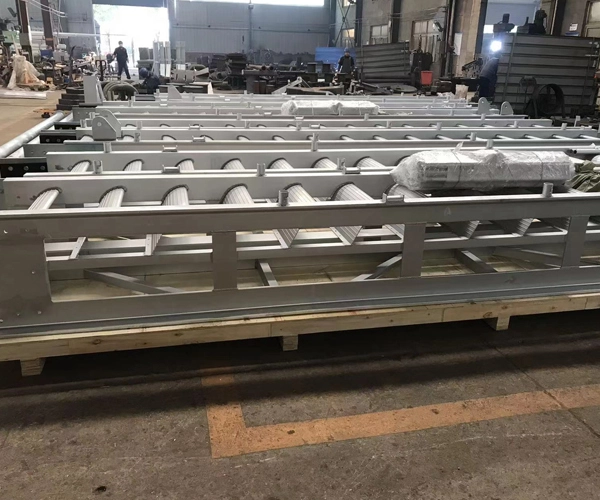A wharf gangway is a passageway connecting the port, dock, and vessel, typically made of sturdy metal or other high-strength materials. It provides a safe and convenient passage for crew members, passengers, and cargo handling personnel. As the global shipping industry continues to develop, the application range of wharf gangways has expanded. They are not only used for traditional ship docking at ports but also play a crucial role in modern port facilities, yacht docks, offshore oil platforms, and other fields.

A typical wharf gangway consists of the following components:
Platform: Located on the dock side, it is typically a solid platform that supports one end of the gangway.
Gangway Ramp: A sloped passage that connects the dock with the ship, often made from metal or composite materials, designed to support certain weight loads.
Handrails and Guardrails: Ensure the safety of pedestrians and prevent falls.
Adjusting Mechanism: Adjusts the angle and length of the gangway based on the height difference and tilt of the ship, ensuring stable connection.
The primary function of a wharf gangway is to provide a safe passage for personnel to embark and disembark ships, while also facilitating the transportation of goods and materials. Depending on the type of ship and port environment, wharf gangways can also feature adjustable or foldable designs to better adapt to different operational conditions.
At commercial cargo terminals, wharf gangways are widely used to connect large cargo ships with docks, ensuring that cargo workers, safety inspectors, and crew can easily and safely board and disembark. Especially at container terminals and bulk cargo docks, workers frequently need to move between different ships for loading and unloading operations. Therefore, wharf gangways must not only support a certain weight but also exhibit strong adaptability, capable of handling challenges such as tidal variations and ship movements.
With the rise of international tourism, cruise tourism has become a popular global travel mode. Cruise terminals require sufficient dock gangways to accommodate thousands of tourists boarding and disembarking. Modern cruise terminals, in particular, demand gangways that can service large numbers of visitors quickly and efficiently while ensuring their comfort and safety. As a result, many cruise terminal gangways are designed with adjustable, telescoping features that allow them to adapt rapidly to the varying heights of ships and their sizes.
On offshore platforms for oil and gas extraction, the use of wharf gangways is critical. These platforms are often located far from shore, with frequent personnel exchanges between ships and platforms in complex environments. To ensure the safety of workers, platforms require sturdy wharf gangways that can withstand the impact of ocean waves, tidal changes, and other environmental factors. Additionally, wharf gangways for offshore platforms are typically designed to be corrosion-resistant, using materials that can endure saltwater exposure, ensuring the long-term stability of the equipment.
At high-end yacht docks, the design of wharf gangways places a greater emphasis on comfort and aesthetics. In these locations, gangways must not only have a robust load-bearing capacity but also feature a visually appealing design to meet the expectations of premium clientele. Many luxury yacht docks use finely crafted wood, aluminum alloys, or stainless steel materials to ensure safety while enhancing the overall aesthetics of the dock.
Wharf gangways also play an irreplaceable role in maritime rescue and emergency services. Rescue personnel, firefighters, and paramedics need to board ships quickly and safely for rescue missions, and the rapid deployment of wharf gangways can greatly improve rescue efficiency. Especially during maritime accidents, the transfer of personnel and supplies between rescue vessels and distressed ships relies heavily on the efficient connection provided by wharf gangways.
The special needs of military ports and docks require wharf gangways to be highly durable and adaptable. In these settings, gangways must endure extreme weather conditions, rapid, frequent operations, and the high-intensity use by military personnel. Consequently, gangways at military ports often use heavy-duty steel, reinforced structures, and feature quick disassembly and reinstallation capabilities.
With technological advancements, wharf gangways are gradually evolving toward automation and intelligence. Future wharf gangways may integrate automatic adjustment, remote control, and sensor monitoring functions, enabling them to automatically adjust the angle and length of the gangway based on the real-time dynamics of the ship, optimizing pedestrian flow and improving operational efficiency. Moreover, with the rising environmental awareness, wharf gangways made from eco-friendly and sustainable materials will become a development trend.
As bridges connecting important facilities such as ports, ships, and offshore platforms, wharf gangways are used across various industries, including commercial cargo transport, cruise tourism, oil and gas platforms, and yacht docks. With the modernization of port facilities and the growth of maritime transport demand, wharf gangways will continue to play a vital role in ensuring the safety, efficiency, and convenience of maritime operations and offshore activities.